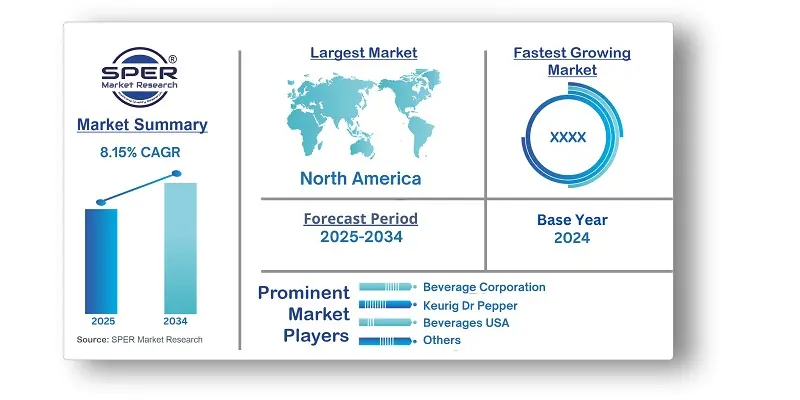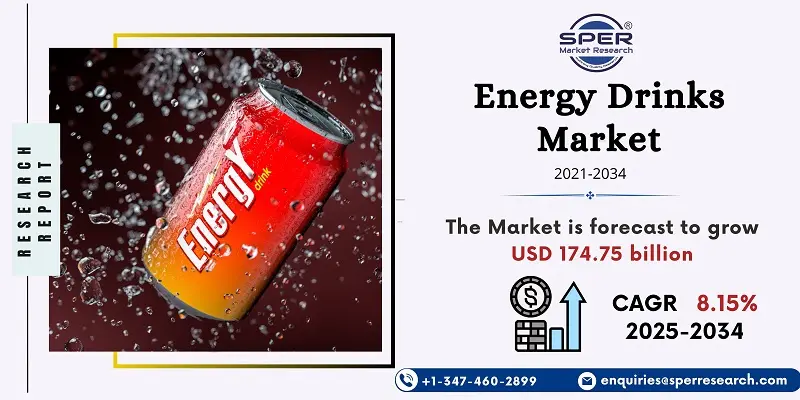
Energy Drinks Market Growth, Trends, Size, Share, Scope, Revenue and Future Challenges
Energy Drinks Market Size- By Type, By Format, By Flavour, By End User, By Distribution Channel- Regional Outlook, Competitive Strategies and Segment Forecast to 2034
| Published: Nov-2022 | Report ID: FOOD2223 | Pages: 1 - 250 | Formats*: |
| Category : Food & Beverages | |||

- January 2024: Celsius Holdings, Inc. expanded its product offerings into Canada, the United Kingdom, and Ireland via PepsiCo, Inc and Suntory Beverage & Food Great Britain and Ireland. PepsiCo is the only distributor in Canada, having extended an arrangement from the United States in 2022. Suntory Beverage & Food Limited was chosen for exclusive sales and distribution in the United Kingdom, Isle of Man, Channel Islands, and Republic of Ireland.
- February 2024: Red Bull GmbH has released its Summer Edition Curuba Elderflower drink in a 250ml container. This flavor, a combination of curuba and elderflower, was available in a variety of formats, including sugar-free alternatives. To accommodate rising demand, the business increased its client base by 50% with its 'Editions' line and developed an 8x250ml mixed sugar-free multipack.

| Report Metric | Details |
| Market size available for years | 2021-2034 |
| Base year considered | 2024 |
| Forecast period | 2025-2034 |
| Segments covered | By Product, By Type, By Packaging, By Distribution Channel. |
| Regions covered | North America, Asia-Pacific, Latin America, Middle East & Africa and Europe. |
| Companies Covered | Amway Corp, AriZona Beverages USA, Keurig Dr Pepper, Inc, Living Essentials Marketing, LLC, Monster Beverage Corporation, PepsiCo, Inc, Red Bull GmbH, Suntory Holdings Limited, Taisho Pharmaceutical Holdings Co. Ltd, The Coca-Cola Company. |
- Global Energy Drinks Market Size (FY’2021-FY’2034)
- Overview of Global Energy Drinks Market
- Segmentation of Global Energy Drinks Market By Product (Energy Drinks, Energy Shots)
- Segmentation of Global Energy Drinks Market By Type (Organic, Conventional)
- Segmentation of Global Energy Drinks Market By Packaging (Bottles, Cans)
- Segmentation of Global Energy Drinks Market By Distribution Channel (On-Trade, Off-Trade)
- Statistical Snap of Global Energy Drinks Market
- Expansion Analysis of Global Energy Drinks Market
- Problems and Obstacles in Global Energy Drinks Market
- Competitive Landscape in the Global Energy Drinks Market
- Details on Current Investment in Global Energy Drinks Market
- Competitive Analysis of Global Energy Drinks Market
- Prominent Players in the Global Energy Drinks Market
- SWOT Analysis of Global Energy Drinks Market
- Global Energy Drinks Market Future Outlook and Projections (FY’2025-FY’2034)
- Recommendations from Analyst
1.1. Scope of the report1.2. Market segment analysis
2.1. Research data source
2.1.1. Secondary Data2.1.2. Primary Data2.1.3. SPERs internal database2.1.4. Premium insight from KOLs
2.2. Market size estimation
2.2.1. Top-down and Bottom-up approach
2.3. Data triangulation
4.1. Driver, Restraint, Opportunity and Challenges analysis
4.1.1. Drivers4.1.2. Restraints4.1.3. Opportunities4.1.4. Challenges
5.1. SWOT Analysis
5.1.1. Strengths5.1.2. Weaknesses5.1.3. Opportunities5.1.4. Threats
5.2. PESTEL Analysis
5.2.1. Political Landscape5.2.2. Economic Landscape5.2.3. Social Landscape5.2.4. Technological Landscape5.2.5. Environmental Landscape5.2.6. Legal Landscape
5.3. PORTERs Five Forces
5.3.1. Bargaining power of suppliers5.3.2. Bargaining power of buyers5.3.3. Threat of Substitute5.3.4. Threat of new entrant5.3.5. Competitive rivalry
5.4. Heat Map Analysis
6.1. Global Energy Drinks Market Manufacturing Base Distribution, Sales Area, Product Type6.2. Mergers & Acquisitions, Partnerships, Product Launch, and Collaboration in Global Energy Drinks Market
7.1. Energy Drinks7.2. Energy Shots
8.1. Organic8.2. Conventional
9.1. Bottles9.2. Cans
10.1. On-Trade10.2. Off-Trade
11.1. Global Energy Drinks Market Size and Market Share
12.1. Asia-Pacific
12.1.1. Australia12.1.2. China12.1.3. India12.1.4. Japan12.1.5. South Korea12.1.6. Rest of Asia-Pacific
12.2. Europe
12.2.1. France12.2.2. Germany12.2.3. Italy12.2.4. Spain12.2.5. United Kingdom12.2.6. Rest of Europe
12.3. Middle East and Africa
12.3.1. Kingdom of Saudi Arabia12.3.2. United Arab Emirates12.3.3. Qatar12.3.4. South Africa12.3.5. Egypt12.3.6. Morocco12.3.7. Nigeria12.3.8. Rest of Middle-East and Africa
12.4. North America
12.4.1. Canada12.4.2. Mexico12.4.3. United States
12.5. Latin America
12.5.1. Argentina12.5.2. Brazil12.5.3. Rest of Latin America
13.1. Amway Corp
13.1.1. Company details13.1.2. Financial outlook13.1.3. Product summary13.1.4. Recent developments
13.2. Living Essentials Marketing, LLC
13.2.1. Company details13.2.2. Financial outlook13.2.3. Product summary13.2.4. Recent developments
13.3. Monster Beverage Corporation
13.3.1. Company details13.3.2. Financial outlook13.3.3. Product summary13.3.4. Recent developments
13.4. PepsiCo, Inc
13.4.1. Company details13.4.2. Financial outlook13.4.3. Product summary13.4.4. Recent developments
13.5. Red Bull GmbH
13.5.1. Company details13.5.2. Financial outlook13.5.3. Product summary13.5.4. Recent developments
13.6. Suntory Holdings Limited
13.6.1. Company details13.6.2. Financial outlook13.6.3. Product summary13.6.4. Recent developments
13.7. Taisho Pharmaceutical Holdings Co. Ltd
13.7.1. Company details13.7.2. Financial outlook13.7.3. Product summary13.7.4. Recent developments
13.8. The Coca-Cola Company
13.8.1. Company details13.8.2. Financial outlook13.8.3. Product summary13.8.4. Recent developments
13.9. Others
SPER Market Research’s methodology uses great emphasis on primary research to ensure that the market intelligence insights are up to date, reliable and accurate. Primary interviews are done with players involved in each phase of a supply chain to analyze the market forecasting. The secondary research method is used to help you fully understand how the future markets and the spending patterns look likes.
The report is based on in-depth qualitative and quantitative analysis of the Product Market. The quantitative analysis involves the application of various projection and sampling techniques. The qualitative analysis involves primary interviews, surveys, and vendor briefings. The data gathered as a result of these processes are validated through experts opinion. Our research methodology entails an ideal mixture of primary and secondary initiatives.



Frequently Asked Questions About This Report
PLACE AN ORDER
Year End Discount
Sample Report
Pre-Purchase Inquiry
NEED CUSTOMIZATION?
Request CustomizationCALL OR EMAIL US
100% Secure Payment






Related Reports
Our Global Clients
Our data-driven insights have influenced the strategy of 200+ reputed companies across the globe.






















